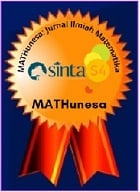PERBANDINGAN TRANSFORMASI WAVELET DISKRIT UNTUK DENOISING CITRA MENGGUNAKAN VISUSHRINK, BAYESSHRINK, DAN NORMALSHRINK
Abstract
Wavelet topics can be applied for image denoising. Wavelet transform is divided into discrete wavelet transform and continuous wavelet transform. Discrete wavelet transform is useful for image denoising, image compression, etc. In this research, we discuss image denoising using wavelets with hard thresholding and soft thresholding. We will also compare results of image denoising using VisuShrink, BayesShrink, and NormalShrink in determining threshold value. In this research, we use grayscale test image with size pixels. To measure algorithm, peak signal to noise ratio (PSNR) value is used. Image denoising uses hard thresholding: PSNR values of Haar, Daubechies 7, and biorthogonal 3.5 wavelets are same for three methods (VisuShrink, BayesShrink, NormalShrink). PSNR value of symlets 11 wavelet is highest for VisuShrink and NormalShrink methods. Whereas, PSNR value of coiflets 3 wavelet is highest for VisuShrink method. Fastest computing times of Haar, Daubechies 7, biorthogonal 3.5, and symlets 11 wavelets are for VisuShrink method. Whereas, fastest computing time of coiflets 3 wavelet is for NormalShrink method. Image denoising using soft threshoding: PSNR values of Haar, Daubechies 7, biorthogonal 3.5, and coiflets 3 wavelets are same for three methods (VisuShrink, BayesShrink, NormalShrink). Whereas, PSNR value of symlets 11 wavelet is highest for VisuShrink and BayesShrink methods. Fastest computing times of all wavelets (Haar, Daubechies 7, biorthogonal 3.5, symlets 11, and coiflets 3) are for NormalShrink method.
Downloads
 Abstract views: 251
,
Abstract views: 251
, PDF Downloads: 188
PDF Downloads: 188










